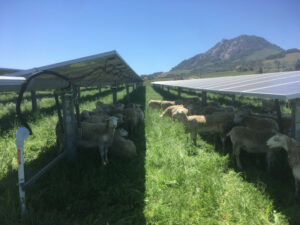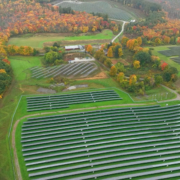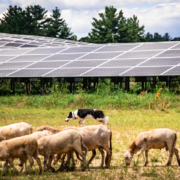NCAT’s AgriSolar Clearinghouse Project Brings Together Solar and Agriculture
 Print This Post
Print This Post
By Chris Lent, NCAT Sustainable Agriculture Specialist
 When I started back to work at NCAT as a sustainable agriculture specialist in August of 2021, after a five-year absence, I was vaguely familiar with the term agrisolar. Having experience working as both a farmer and a solar energy installer, I was aware of an explosion of new solar development projects happening across the country. I also knew that soil identified as prime farmland is, in many cases, prime land for solar development. But not until the Energy team at NCAT, which created a project called the AgriSolar Clearinghouse (ASC), kindly carved out a spot for me, did I realize the full extent of the opportunities to co-locate solar panels with agricultural practices, and the multitude of benefits that can come from that.
When I started back to work at NCAT as a sustainable agriculture specialist in August of 2021, after a five-year absence, I was vaguely familiar with the term agrisolar. Having experience working as both a farmer and a solar energy installer, I was aware of an explosion of new solar development projects happening across the country. I also knew that soil identified as prime farmland is, in many cases, prime land for solar development. But not until the Energy team at NCAT, which created a project called the AgriSolar Clearinghouse (ASC), kindly carved out a spot for me, did I realize the full extent of the opportunities to co-locate solar panels with agricultural practices, and the multitude of benefits that can come from that.
NCAT defines agrisolar as combined land use for solar energy and agriculture. It includes grazing livestock under and around solar panels, developing pollinator habitat and apiaries near solar arrays, growing crops under and around solar panels, and powering agricultural operations with solar energy. Other terms like agrivoltaics, aquavoltaics, and orchardvoltaics also fall into broader category of agrisolar.
As utility-scale solar production increased more than tenfold in the past seven years (U.S Energy Information Administration), and with opportunities for agrisolar applications quickly on the rise, NCAT identified the need for a central location to gather and share the most up-to-date, peer-reviewed information on agrisolar, facilitate a relationship-building network, and foster the development of best practices. NCAT is ideally suited to perform this work, with decades of experience as a trusted, practical connector of sustainable energy and sustainable agriculture information. NCAT developed a network of 30 organizations, including the leading agrisolar experts in the country. This AgriSolar Clearinghouse group works to promote the co-location of solar and agriculture in a way that is beneficial to both. Together with these partners, NCAT applied for and received a three-year, $2.03 million cooperative agreement with the U.S. Department of Energy’s Solar Energy Technologies Office within the Office of Energy Efficiency and Renewable Energy.

Pollinator-friendly solar development. Photo: Rob Davis
The AgriSolar Clearinghouse website provides the latest research in the field of agrisolar and information on solar regulations, policies, and funding opportunities. ASC also provides technical assistance, case studies, on-farm solar tours, and the facilitation of peer-to-peer learning opportunities. Solar developers, landowners, farmers, educators, researchers, pollinator advocates, and the public are invited to visit the site, join the forum, and utilize the extensive information resources housed there.
One prominent example of a mutually beneficial agrisolar application is livestock grazing to manage grasslands under a solar installation. This practice is less expensive for solar developers when compared to landscaping or mowing contracts, and at the same time, it can provide pastureland and contract income for livestock farmers. The American Solar Grazing Association is a stakeholder in the ASC project and has been working to promote solar grazing across the country.
Growing crops under solar panels can offer benefits for preserving soil moisture. Greg Barron-Gafford’s research at Biosphere 2 in Arizona has shown that soil moisture is preserved and certain crops can perform as well or better in the partial shade microclimate created by the panels. Another important practice in agrisolar is planting pollinator-friendly habitats and developing apiaries at solar developments. Pollinator plantings can control erosion, cool the area under the panels increasing solar panel efficiency, and create habitat for pollinators.
Whether your agrisolar interests lie in livestock grazing, solar development, crop production, farm energy efficiency, water conservation, soil improvement, beekeeping, or pollinator conservation, when you visit the Agrisolar Clearinghouse website, you will find an information library with current peer-reviewed articles and papers on these and many other topics. You will also find webinars and blogs on the latest research in this new field of study. Stories and case studies about agrisolar developments, new technologies, and unique solar energy models can be found in the Media Hub section of the site. The forum allows participants to make connections, share information, and contribute to the conversation.

Grazing sheep can benefit from the shade provided by solar panels. Photo: Seeta Sistla, California Polytechnic State University
While common questions about agrisolar are answered in the Q&A page on the website, more specific questions can be brought to us by chat, email, or phone (connect here). The agrisolar team at NCAT, as well as our project partners, can provide one-on-one technical assistance. If you have a farm and are thinking of the possibilities of solar energy, you no doubt have some questions about how and where to get started.
NCAT works with over 30 partners and stakeholders on the ASC project, including national energy laboratories, the Smithsonian, universities, the solar industry, agriculture, pollinator organizations, solar grazing associations, and rural policy centers across the country. In addition to helping with technical assistance, partners are working with NCAT to develop best practices, educational material, webinars, publications, and a podcast series. Partners have also agreed to act as mentors for the peer-to-peer learning component of the project. As a part of the ASC networking mission, we are connecting and facilitating mentor relationships between less-experienced agrisolar developers and farmers, developers, grazers, and researchers who have specific knowledge, skills, and experience in agrisolar best practices.
There is a lot riding on how well we can combine the benefits of solar power and agricultural practices in this new era of alternative energy and climate change. Will farmers be able to take advantage of land leasing for solar development to diversify their income streams and still produce crops or livestock on that land? Can we use the same land base to reduce our use of carbon energy sources and sequester carbon in the soil? Will this country lose quality agricultural land while trying to develop another valuable resource, sunlight, for energy production? These are complex questions that are affected by the decisions of landowners, farmers, solar developers, and local governments. NCAT’s AgriSolar Clearinghouse can bring these people together, provide trusted, practical information, and help them make good decisions in their applications of agrisolar.
Related ATTRA Resources:
Solar-Powered Livestock Watering Systems
Voices from the Field Episode 216: Sheep and the Sun: Solar Grazing with Lexie Hain
Other Resources:
Solar Beekeeping Agreement Template
Remarkable Agrivoltaic Influence on Soil Moisture, Micrometeorology and Water-use Efficiency
Opportunities for Agriculture and Solar in the Urban Fringe: The Antelope Valley as a Case Study
Farmland Solar Policy Design Toolkit
Rural Energy for America Program (REAP) Renewable Energy & Energy Efficiency
This blog is produced by the National Center for Appropriate Technology through the ATTRA Sustainable Agriculture program, under a cooperative agreement with USDA Rural Development. ATTRA.NCAT.ORG.









 USDA NRCS
USDA NRCS
